WARNING
The load data contained on this site is intended for use with specific rifles and components. Other manufacturers’ equipment will not produce equivalent pressures or velocities. Data contained herein is therefore for the purpose of comparing loads and results against the Reach-ban benchmark grades only, and are not intended for use by individuals – even those who are familiar with correct and safe handloading practices and procedures.
Target Shooter has not set out to produce reloading data but rather to offer alternatives to powders now unavailable due to REACH controls and it is up to the reader to interpret this data to suit his or her requirements and thus no responsibility is assumed in the use of this data. The information is to be used at the sole discretion of the user and the user assumes all risk.
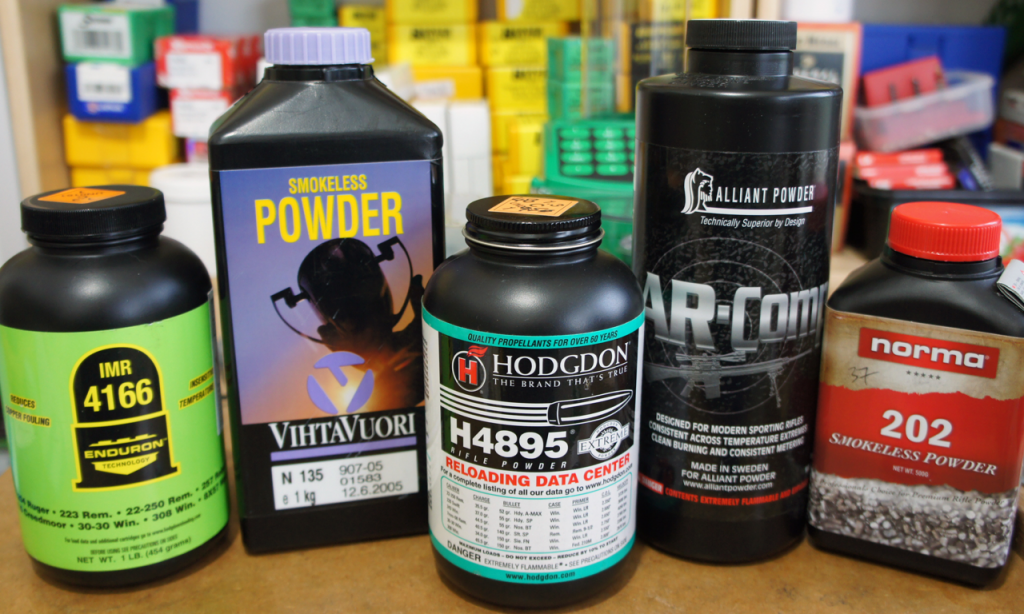
Hodgdon H4895 and VarGet Alternatives Part 3
There are four more extruded VarGet (VGT) alternatives that I range-tested last year, all from Vihtavuori. But first, I promised that I’d rerun the top (25gn) load of VarGet to see if MVs had increased above the lower than expected 2935 fps now that the barrel has several hundred rounds through it. Yes, I did, and yes, they did – to a new average of exactly 3000 fps, slightly above my original QuickLOAD (QL) prediction. This test used a different powder lot, so that probably affected the result given this grade’s reputation for variability, but I suspect that a significant part of the increase came from the increased barrel round count. (I remeasured H4895 MVs too, both sessions in this instance using powder from the same tin, and MVs also rose, by around 40 fps in this instance).
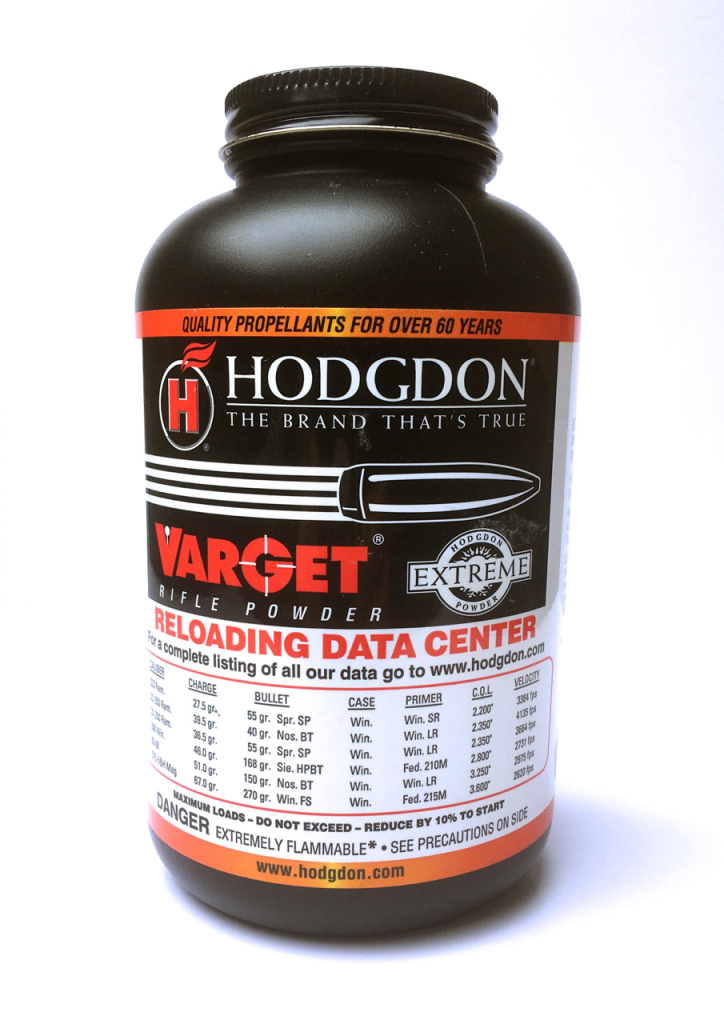
Moving onto the Viht products, it says something about just how large this company’s range is these days when I can say that I looked at no fewer than six of its powders in this fast to mid burn speed bracket (Viht N530 to N550 inclusive, of which N530 and 135 fall into the H4895 part of the exercise). Those covered here as potential VGT equivalents are in ‘quickness’ order: N140, 540, 150, and 550 fast to slow. Ah, but hang on a minute you say, surely N150/550 are much slower burners than the Hodgdon product? If you take relative burning rate charts as gospel, that is indubitably so, this pair often shown as equivalents to the 4350s. However, as was seen in the H4350 alternatives exercise, even N550 (the ‘slower’ one of the twin grades) was far ‘faster’ than H4350 in the 7mm-08 running at considerably lower charges when pressure signs kicked in. The reality appears to be that there is less difference between the N140/540 and N150/550 pairs than burn-rate charts, QL default settings, or ‘received wisdom’ usually suggest. That is not necessarily unwelcome as it allows fine-tuning of loads in many cartridges to suit individual rifle preferences. In the 223, the N150/550 pair only come into their own with 85gn and heavier bullets allied to very long throated chambers, but still seemed worth a try with the 77gn SMK in this rifle. (Vihtavuori provides loads for both grades with the 80.5gn Berger Target BT Fullbore bullet and N150 alone with heavier projectiles).
Old Stager
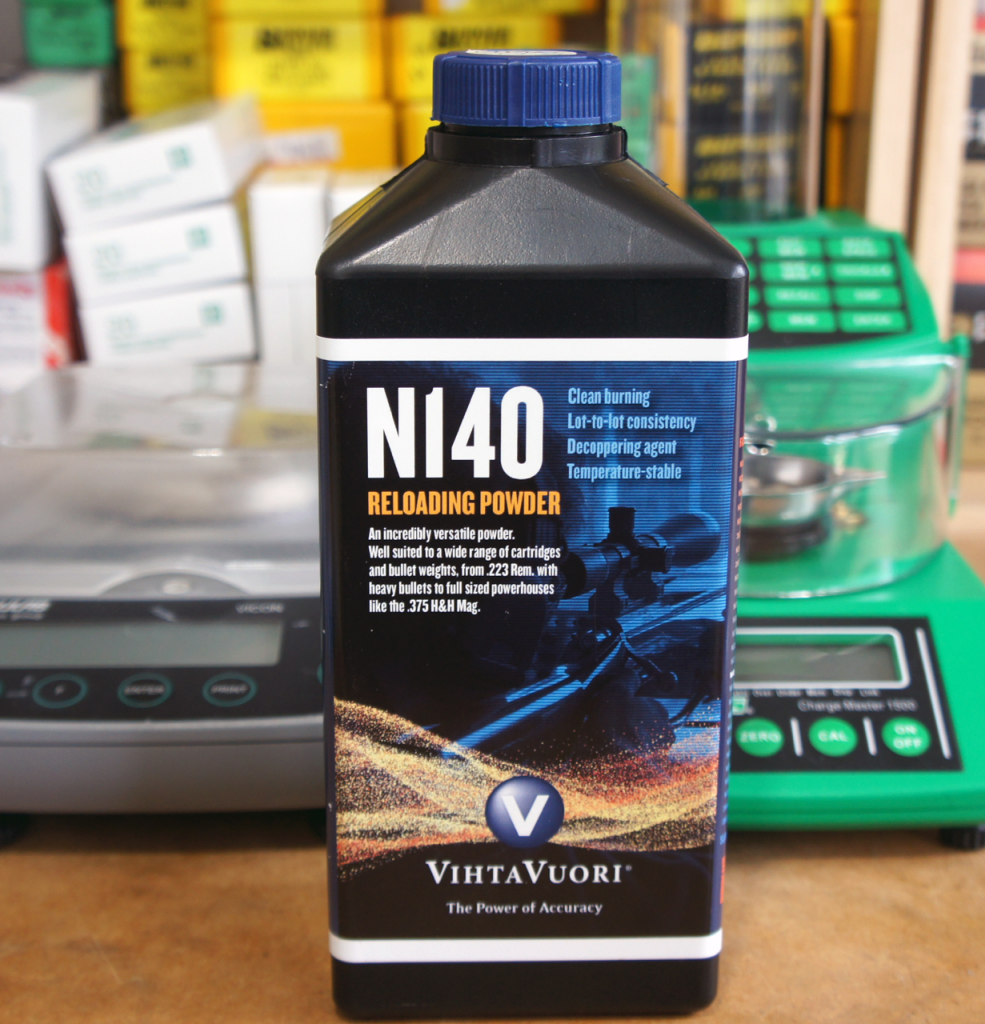
Kicking off with the lowest numerical designation / ‘fastest’ Vihtavuori grade of the quartet, we have long-established N140. I can remember its arrival in the UK in the early 1980s when the long-gone West Yorkshire ammunition and components distributor Mountain & Sowden Ltd introduced it alongside slower burning N160. That was the entire Viht range available to us back then, just two rifle grades. They sold well but, it was only when Tim Hannam, predecessor of today’s Hannams Reloading Ltd., took over the import franchise a few years later that more grades including pistol products were added and Viht became so widely used.
N140 has always been a top-seller, unsurprising as it is such a good, consistent performer across many of our most popular cartridges – 308 Winchester; 223 Rem (with heavier bullets); 22-250 Rem; 6mm BR Norma; nearly all the late 19th/early 20th century military numbers like our 303 and its 7.92X57mm mortal enemy. It also works for others that usually need slower burning powders in the 4350s / Viht N160 class for optimal performance, if lighter bullets are selected. In the 223, it’s just usable with 55gn bullets, and ideally suited to 69-80gn models, especially the 77gn SMK allied to the rifle’s long-throat set-up used in these tests.
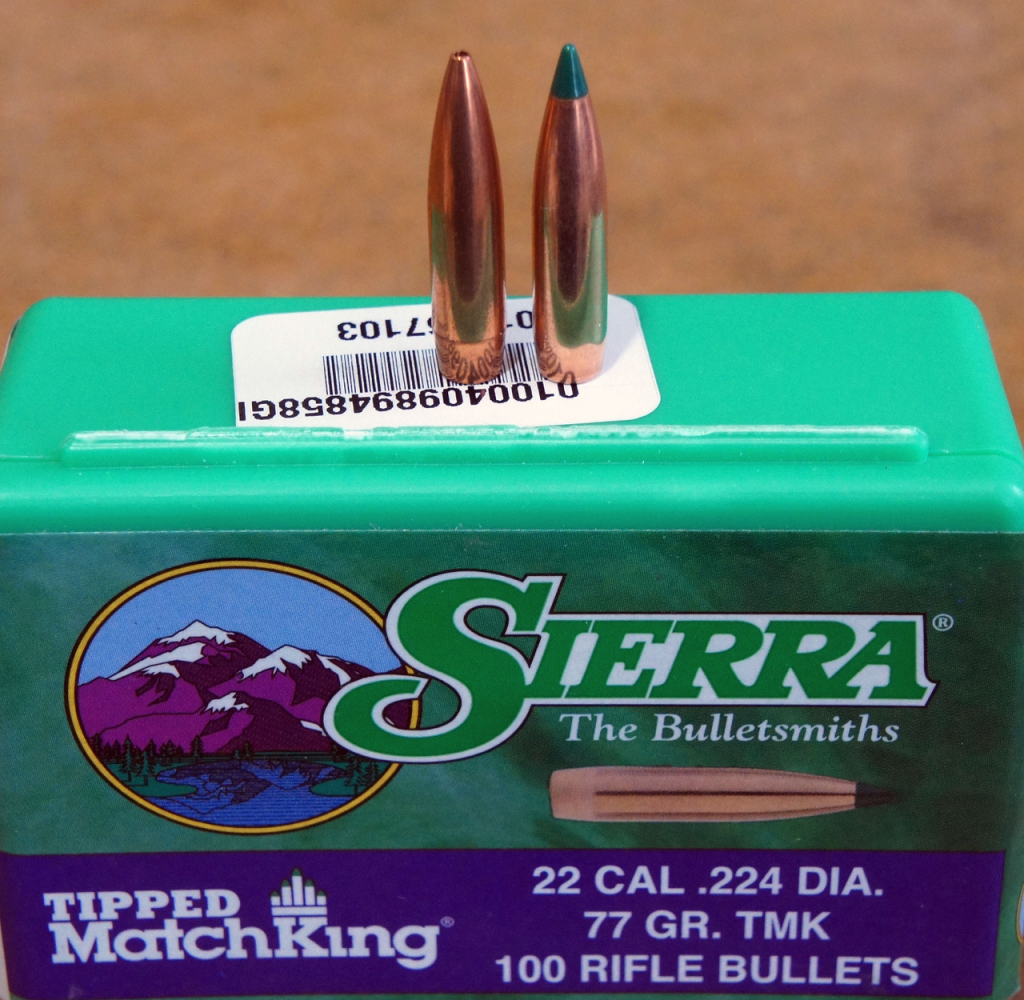
QuickLOAD v.3.6 computed 25.0gn would produce 2996 fps at 58,492 psi in my longer-throat / 30-inch barrel set-up using the heaviest (30.5gn water capacity) lot of my Lapua ‘Match’ brass. As before, the primer was the old PMC brand SR Magnum with its ‘tough’ cup. Viht’s reloading data gives a maximum of 24.7gn N140, which surprisingly rises to 25.5gn with the acetyl-tipped TMK version of the 77gn match bullet. (The common or garden 77gn MatchKing and its ‘Tipped’ variant have the same body-shape, bearing surface length and suchlike, so loads should also be the same unless there are hidden differences such as the TMK using a thinner jacket.) But these charges are for 2.26” COAL, presumably in the standard SAAMI chamber with its short freebore. With my additional-freebore chamber and longer COAL, the factory charges’ equivalents rise to around 25.4/26.2gn respectively for the pair, although in practice, the latter would be too heavily compressed. Given QL’s regular over-estimation of maximum charges for Viht powders, I was still suspicious despite these relatively high Viht figures, so loaded up nine four-round batches from 22.7 to just over 25gn, load compression starting at that weight.

Then I went to the range and left the chronograph at home, didn’t I? Fool! N140’s first range outing was therefore simply for groups and pressure signs – good for the former, nothing to worry about for the latter. The nine 4-round groups averaged 0.3” covering a 0.2” to 0.45” range with POIs barely rising and only very gradually moving left as charges rose. Very good indeed! To get MVs, five further batches were loaded from 24 to 25gn, as shown in the target scan. MVs rose by 130 fps over the one-grain range. Group wise, these weren’t quite as good as those from the previous outing at 0.21 to 0.46”, but note they are now five-rounds. At 3007 fps average, the top (25gn) charge was very close to QL’s predicted 2996 fps, and also to the revised 3000 fps MV for our VGT benchmark. However, in order to achieve this, pressures had to be higher than my 55,000 psi ‘target’, QL estimating them at around 59,000 psi – still within the allowed CIP range, but higher than VGT likely needed. OK – everything hunky-dory then, well except ………… ! Where do Viht’s charges fit in with these results? That 24.7gn is going to be a very ‘hot load’ in a true standard SAAMI chamber and, the 25.5gn TMK maximum has to be problematic on a number of counts. So, be very careful with these factory maximum charges! So far as this grade serving as a VGT alternative goes, the answer is positive, MVs and performance being very close to my revised MV value for the Hodgdon powder, albeit probably employing higher pressures.
Stuffed Full!
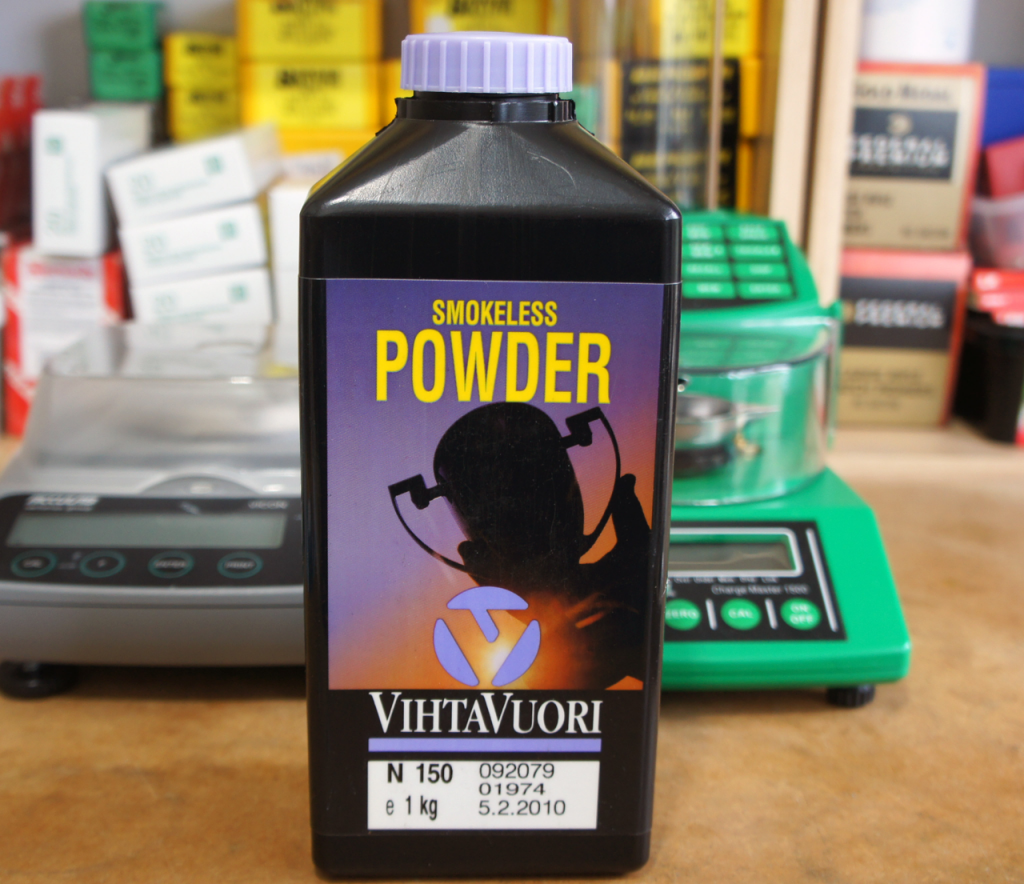
Let’s stick with the N100 series single-based options and move onto N150. This always looked ‘iffy’ as the issue was getting enough of it into the little case to achieve normal working pressures. Viht doesn’t give loads for the powder with the 77gn SMK, but does for the slightly heavier 80.5gn Berger LRBT – also 24.7gn maximum as per N140. With a COAL of only 2.244” shown in the company’s data, I’d have expected extremely heavy charge-compression from this combination, but Viht doesn’t mark it up as such. QL thinks otherwise, and reverting to my 77gn SMK test loads, showed everything above 23.6gn suffering from this condition despite the extra 140 thou’ COAL and increased combustion chamber volume resulting from the rifle’s long chamber-throat. The problem there was that 23.6gn was computed to produce just below 40,000 psi, way too low for decent performance, probably also consistent results. In the event, I loaded eight batches from 23.4 to 26gn, the latter estimated at 110% fill-ratio by the program, ie very heavily compressed. Even so, this charge weight was computed to be only just nudging 55,000 psi. Loading up the 30-odd cartridges confirmed QL’s outputs in this factor at least, with noticeable charge compression starting at 24.6gn and COALs starting to increase due to push-back on the bullet bases. Hmmm …. Dodgy!
On the range, actual results showed a return to the serial Viht powders’ issue of higher MVs (and therefore pressures) than QL v.3.6 was calculating from its default powder values. There was a 100 fps or even greater increase on the estimated MVs across the entire weight range used, my top charge of 26.0gn achieving an impressive 3,083 fps compared to QL’s predicted 2962! Although groups look OK at first sight, they’re larger across the board than those obtained with N140, now ranging from 0.3 to 0.5-inch and averaging around 0.4”. Some strings’ MVs were surprisingly consistent, three with single-figure spreads and a couple in the teens. Nearly all rounds had seen COAL growth between loading and use showing as a slight resistance to chambering as bullet ogives started to engage the lands – nothing like a full ‘hard jam’, but ‘in’ enough to raise pressures and MVs. Primer cratering started at quite low loads, but didn’t become ‘serious’ until top charge weights were reached. With 25.0gn’s 2982 fps not far short of VGT’s revised 3000, the powders appear closer than many would expect, but N150’s charge-compression / COAL / bullet in the lands issue might distort performance and results. So, in this cartridge, N150 is a poor choice all round, at least with this bullet. It does work very well as a VGT alternative in many roomier cased designs such as 308 Win though.
Hot Stuff
So that leaves us with the two ‘High-Energy’ infused nitro-glycerine grades in this bracket, N540 and 550. All such N500 series powders have now been treated to reduce temperature sensitivity, also as with the N100s, to incorporate an anti-coppering agent. Unlike some of the ancient powder lots I use in these tests, N140 and N540 utilised newly purchased ‘fresh’ lots, so should incorporate Viht’s latest improvements, and I don’t have to worry about performance inducing changes caused by long storage, such as losing moisture content. The N500 series powders have an advantage over their single-based N100 counterparts, increased energy and performance aside – infusing nitro-glycerine into the kernels increases their weight, that is bulk density rises, and charge-compression is less of a problem. This is especially so with N550 v N150 in the little 223 Rem case, it holding an additional grain-plus weight of powder at any particular fill-ratio.
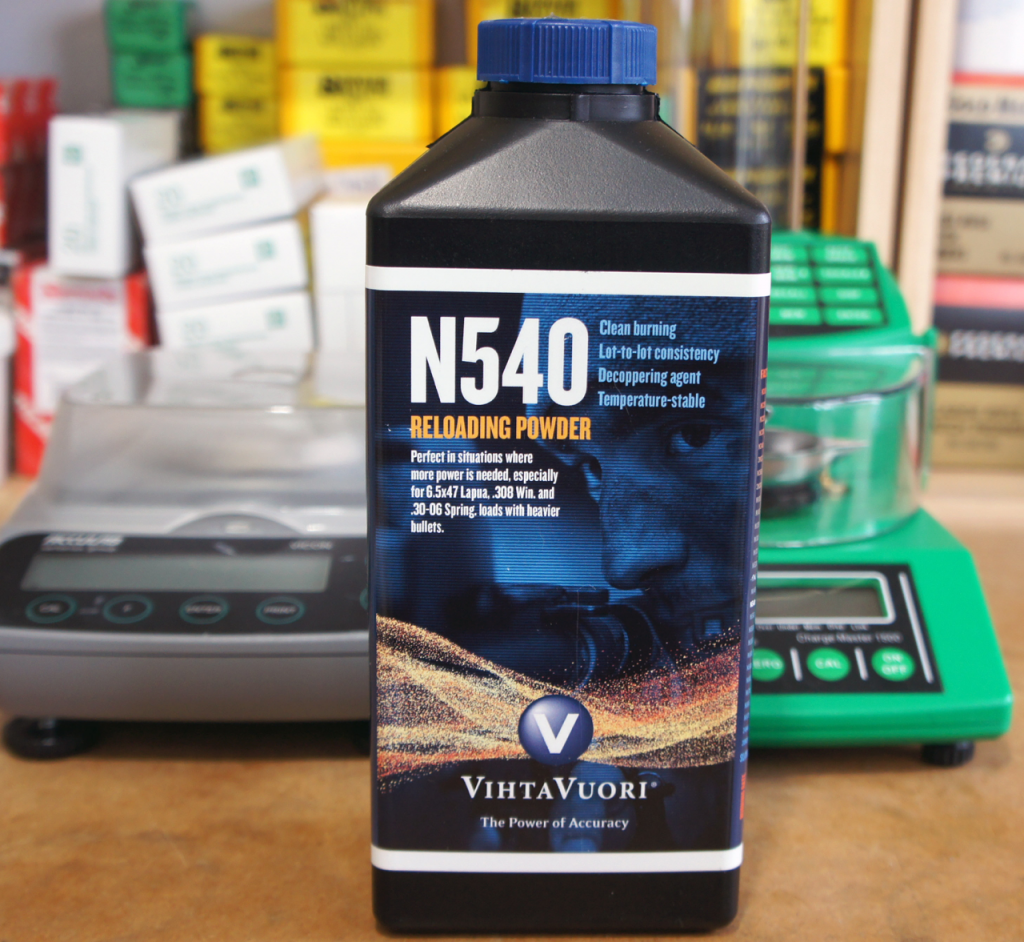
N540 is indeed a ‘high-energy’ propellant, Viht classifying it as 4000 J energy per gram weight. However, whilst that is high by Viht N100 series levels (3500 to 3750 J/g depending on the grade), it’s in line with those quoted for our benchmark H4895 and VGT, and more or less equal to many grades in the Alliant and Reload Swiss powder ranges. Nevertheless, my ‘gut feeling’ tells me that N540 is ‘hotter’ than the others, and I’m sure Vihtavuori used to give it a nominal 4100 J/g rating. As a result, I’ve stayed clear of this powder over the last 12 or so years, not trying it in anything since my early load development with 90gn bullets in 223 Rem using a ‘super-freebore’ chambered barrel. Viht’s maximum for the old Sierra 77 MK is 25.3gn, but that’s with the SAAMI 2.26-inch COAL, and one presumes, tested in a SAAMI short-freebore chambered barrel. On my rough and ready equivalence factor, my rifle’s longer freebore therefore allows a full 26gn before exceeding the manufacturer’s tested load pressures. QL v.3.6 supports that contention with 26.1gn computed to just remain within CIP allowed pressures for an impressive 3,058 fps from the 30-inch barrel, albeit at a high 60,741 psi. As with N140, I was suspicious of both sources and loaded up a good range of charges from 23.0gn to 25.4gn, reducing increments to 0.2gn after 25.0gn. My penultimate 25.2gn charge was calculated to produce 2970 fps at just over 54,000 psi, pretty well ideal in relation to my objectives.
Yet again, this outcome wasn’t to be! 25.2gn produced an actual MV of 3061 fps, which would need over 60,000 psi according to the program. Very heavy primer cratering appeared at this charge level too. My top charge weight of 25.4gn produced a large MV increase – to 3,108 fps or + 47fps – for a mere 0.2gn charge increment. Until that point, MVs had increased by 12-15 fps per 0.1gn powder, so this was a near doubling. The primer now clearly showed over-pressure signs going from heavily cratered but retaining rounded edges with the 25.2gn charge, to no cratering, a shallow pin indentation, and very flat appearance with no radius to the edges. That 25.4gn charge round was the sole one fired, the other three going home with me to be pulled. So, despite my rifle chamber’s considerable additional freebore, 25.2gn turned out to be the maximum usable load, in fact still rather too high from the primer cratering evidence, and 25gn would be the absolute ceiling with this combination in my gear, but more likely lower still at 24.7gn based on actual MVs obtained. Yet, old fuddy-duddy conservative (or so many claim) Vihtavuori publishes 25.3gn maximum for this bullet and in the shorter, higher-pressure SAAMI chamber too! This isn’t a case of applying the commonly used warning caveat emptor (let the buyer beware), rather caveat usor (let the user beware!) in my opinion.
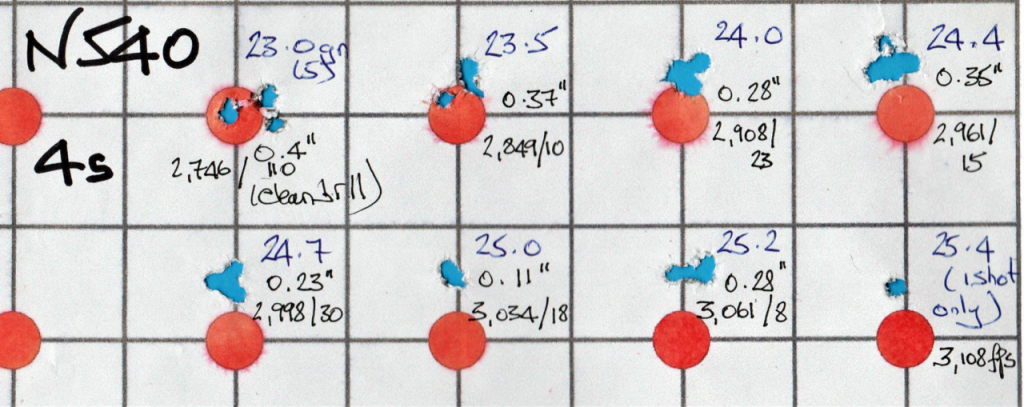
This wasn’t a day for pressures, MVs or anything other than group sizes to be increased by ambient conditions either. As with some other test-cards, target visibility had been an issue when shooting, but no longer thanks to clear skies and unbroken sunshine creating down-range mirage. This was mid-November Diggle with normal weather services having resumed: under 10-deg C; half-dark; solid vertical curtains of dense drizzle connecting the cloud-base only a few hundred feet above us to the hillsides, slowly drifting across the sightline at 90-degrees in a light wind. By holding back in the worst conditions, groups remained good, but even with restricting shooting to the not quite so bad periods the Labradar failed to track one bullet in four. Setting the first group which was fired from a clean barrel aside, the other six 4-round groups averaged 0.27” ranging from 0.11 to 0.37”. That just over a tenth-incher is the smallest 4-round group fired in this test-series to date. It’s a shame that as noted above, I rate the 25.0gn charge that produced it as being marginally on the ‘warm’ side with its 3,034 fps MV and likely Pmax at c.59,000 psi. The closest equivalent MV to 25gn VGT’s 3,000 fps was produced by 24.7gn N540, not too different and producing similar pressures according to QL.
Nice N550 Surprise
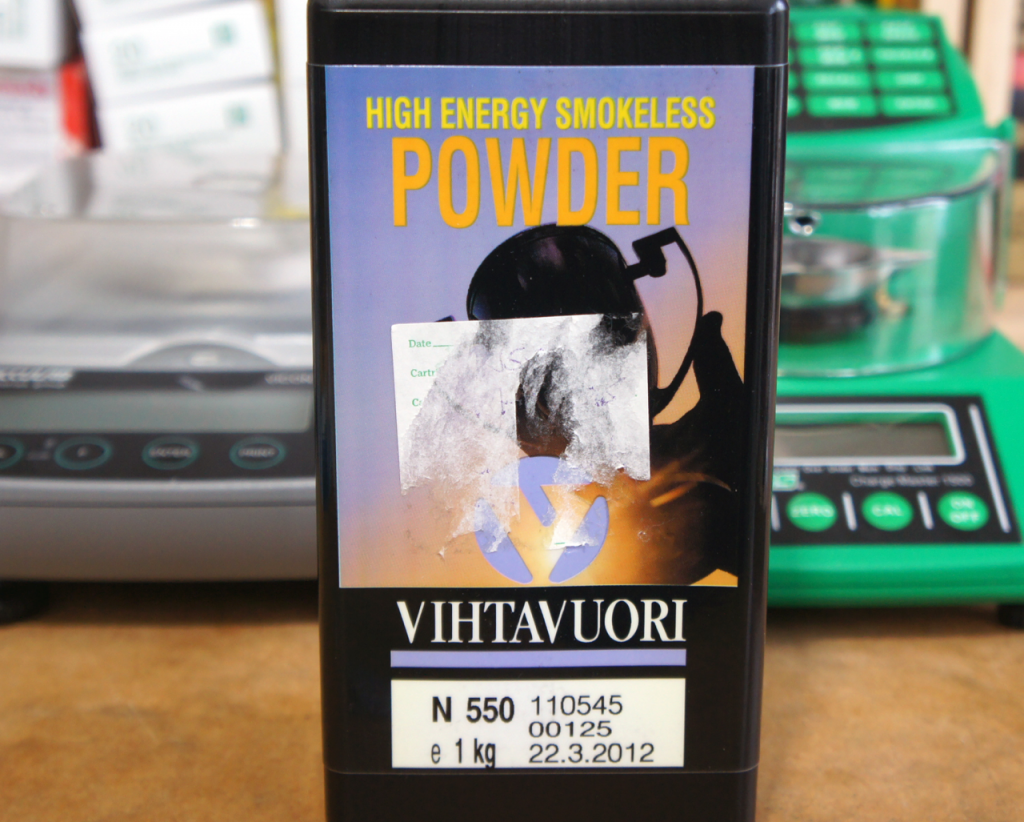
With N150’s deficiencies, the omens didn’t look over-good for its ‘high-energy’ partner. QL v.3.6 though reckoned I could load it up as high as 27.5gn (108% fill-ratio) for 3055 fps / 54,009 psi Pmax. However, this is the same N550 that produced significantly higher MVs and pressures than QL had calculated in 260 Rem and 7mm-08 Rem, so prudence with fill-ratios aside, pressure concerns kept me cautious. (Note too, my N550 came from an elderly production lot – today’s reformulated version might behave slightly differently.) This time around, there was no back-check available from Viht data for this bullet, although the company shows N550 for the Berger 80.5gn LRBT at a mere 2.244” COAL and a very healthy maximum charge weight of 26.9gn. That load’s notation says ‘compressed’ – ‘It certainly will be!’, I thought. In any event, 26.9gn was my choice too for my top 77gn SMK charge, QL calculating 105% fill-ratio even with the 2.400” COAL alongside 2,988 fps MV from just under 50,000 psi. From the QL program’s and powder’s previous histories, discretion was indicated, so no fewer than 10 batches were loaded up starting at 24.0gn and using 0.2gn charge increments once past 26gn. Sure enough, actuals ran consistently higher than predictions, my top load of 26.9gn producing 3,091 fps instead of QL’s 2,988. Nevertheless, with this powder’s characteristics, QL indicated that higher value was obtained at only 56,200 psi. Primer condition supported this, the Savage’s firing pin / bolt combination only producing moderate cratering for the 26.7 and 26.9gn lots, consistent with loads just starting to ‘warm up’ once around 55,000 psi. Unlike with N150, no serious compression indications were felt during bullet seating and all 40 rounds turned out at the desired comparator-measured COAL plus or minus one thou’, retaining it between the loading and range sessions.
There was one possible cloud in this otherwise clear sky. If you analyse movements in the recorded MVs on the target scan, there is a large jump between 26.0 and 26.3gn from 2946 to 3018 fps, or 24 fps / 0.1gn. Normally, such a ‘velocity spike’ would indicate a considerably larger ‘pressure spike’ and be interpreted as a sign of imminent catastrophe with any further increase producing major problems – as I’d assumed with my top N540 charge. The late, very talented Californian sling shooter Jerry Tierney who did a huge amount of expert development work with 223 and heavy bullets in ICFRA disciplines, had the same experience with N550 and 90gn Bergers many years back – and promptly terminated shooting with that combination. In my case, there were no other pressure symptoms – and my Savage’s bolt is a very reliable indicator via primer cratering. My QL incremental printout also showed Pmax at an estimated 52,000 psi for c.3020 fps with the powder, so I carried on firing the last three batches. (This is where mere 0.2gn charge weight increments provide much comfort!) This final trio produced incremental MV rises of 12, 15, and 9 fps / 0.1gn – ie same as lower charges before the ‘spike’. What caused it then? In this case, I think it was pressures passing the 50,000 psi mark and helping the powder charge burn more completely and efficiently. This phenomenon is most often seen with ball-type powders, but sometimes shows up with the Viht N500s too. I’ll stress though, that such a change in MV increase is usually a danger sign and more often than not indicates: “Stop right there!”
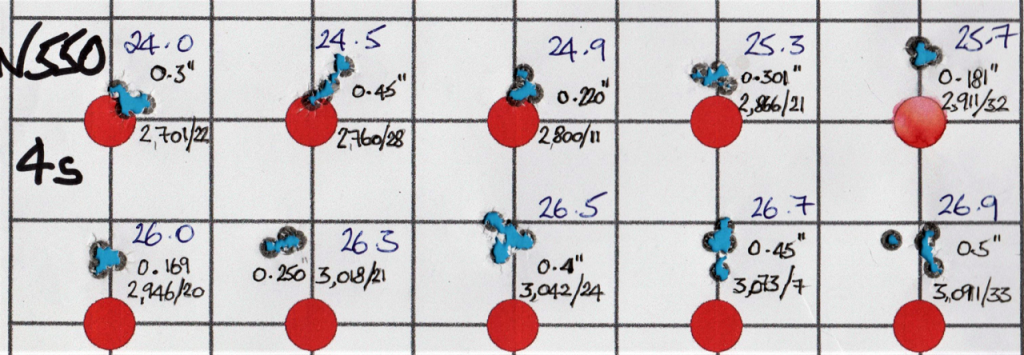
Groups then? Assuming you’ve perused the target scan, you’ll have seen they were very good indeed. In near ideal testing conditions, they averaged just under a third inch. Discounting the last couple with the highest charges, that were also showing ‘warm load’ pressure signs through primer cratering, that average drops to 0.28” for eight groups ranging from 0.169 to 0.45-inches. The five consecutive incremental charges from 24.9 to 26.3gn producing a 200 + fps MV range were all under quarter-inch. To use the vernacular, I was ‘gobsmacked’, but in a happy way of course. I didn’t expect good outcomes from the combination at all, never mind some of the best seen to date in this rifle. However, unlike N140’s results, charge weight and resulting MV changes also altered POIs with a steady increase in elevation across some three-quarters MOA until 26.5gn where it stabilised for the final three charges, by which point groups had opened out c. 0.45”, unfortunately.
Interesting as all this is, how does N550 stack up against VGT then, the answer to this question still being the purpose of the exercise? At nearly 3100 fps recorded for the top N550 charge, it’s capable of producing higher MVs in this case-capacity to bore-area ratio design even in the heavily constrained conditions produced by the little 223 Rem case. The nearest N550 MV equivalent to VGT’s revised 25gn/3000 fps result was 26.3gn, the point at which the MV ‘spike’ occurred, QL reckoning on c. 52,000 psi being produced. So, unsurprisingly, it’s a considerably ‘slower’ powder, falling between the VGT / Re15 / RS50 etc group and the 4350s, but somewhat closer to the former. It’s certainly usable and effective in the 308 Win, especially with bullets heavier than 175gn, although F/TR experience shows that plain old N150 without any added nitro-glycerine delivers the goods with heavy bullets effectively and reliably.
Returning to actual results rather than powder comparisons, would I recommend this powder in 223 with 80gn bullets? No, not at all. I think this was the sort of freak result that one occasionally encounters in handloading which gives excellent results in a particular components-chamber combination, maybe in a particular barrel, but which usually doesn’t stand extrapolation to apparently equivalent mixes. Subsequent testing with a series of five-round groups confirmed these good results with the 77gn SMK and 26gn N550, but loading the much more ballistically capable 80gn Sierra MK over small charge ranges of N140 and N550 based on the 77gn findings gave markedly better results from the first of these – as one would expect, N140 being much better matched to the internal ballistics’ requirements. There is also the issue of the N500 series powders’ reputation for being hot – ‘double-based barrel-burners’ in popular parlance. Things are more nuanced here. My 26gn 77gn SMK follow-up test load gave an average MV of just over 2930 fps in my rifle, which QL calculates as only producing c.47,000 psi peak pressure. ‘Normal’ powders for the combination are running at ~8000 psi higher pressures. It’s conceivable therefore, that N550 might actually give better barrel life in this particular situation thanks to the significant peak pressure reduction. On the debit side, running at such a low pressure, well ‘out of the groove’, will likely produce inconsistent results over extended shooting periods and varying conditions. Conversely, if N540 is as ‘hot’ as my gut-feeling warns, the 25gn charge producing that stunning group in the low ‘ones’, but at an estimated 59,000 psi, will almost certainly increase barrel wear.
This concludes my look at extruded VarGet alternatives. The next part continues with H4895, our second benchmark grade, and four potential extruded equivalents.
